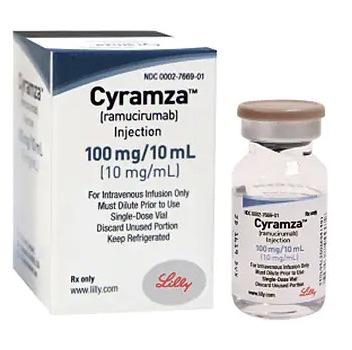Cyramza Disease Interactions
There are 8 disease interactions with Cyramza (ramucirumab).
- Bleeding
- GI perforation
- Hypothyroidism
- Liver dysfunction
- Hypertension
- PRES
- Proteinuria
- Thromboembolic disorders
Ramucirumab (applies to Cyramza) bleeding
Major Potential Hazard, Moderate plausibility.
Ramucirumab may increase the risk of bleeding. Patients have experienced gastrointestinal hemorrhage, including severe and sometimes fatal hemorrhagic events when using this agent. Permanently discontinue ramucirumab in patients experiencing severe bleeding.
References
- "Product Information. Cyramza (ramucirumab)." Eli Lilly and Company (2014):
VEGFR (applies to Cyramza) GI perforation
Major Potential Hazard, Moderate plausibility. Applicable conditions: Gastrointestinal Obstruction, Gastrointestinal Perforation, History - Radiation Therapy
Inhibitors of vascular endothelial growth factor receptors (VEGFR) may cause gastrointestinal perforation and fistulae. Avoid use of these agents in patients with ovarian cancer who have evidence of recto-sigmoid involvement by pelvic examination or bowel involvement on CT scan or clinical symptoms of bowel obstruction. Permanently discontinue these agents in patients with gastrointestinal perforation.
References
- "Product Information. Avastin (bevacizumab)." Genentech (2004):
- "Product Information. Votrient (pazopanib)." GlaxoSmithKline (2009):
- "Product Information. Cyramza (ramucirumab)." Eli Lilly and Company (2014):
Ramucirumab (applies to Cyramza) hypothyroidism
Moderate Potential Hazard, Moderate plausibility.
Hypothyroidism has been reported in patients taking ramucirumab. Therapy with ramucirumab should be administered cautiously to patients with thyroid dysfunction. Baseline laboratory measurement of thyroid function is recommended and if appropriate, treatment per standard medical practice should be given prior to initiation of therapy. Clinical monitoring of thyroid function is recommended during therapy.
References
- "Product Information. Cyramza (ramucirumab)." Eli Lilly and Company (2014):
Ramucirumab (applies to Cyramza) liver dysfunction
Moderate Potential Hazard, Moderate plausibility. Applicable conditions: Liver Disease
The effect of hepatic impairment on the clearance of ramucirumab was evaluated in patients with mild and moderate hepatic impairment. No clinically important differences in the clearance of ramucirumab were found between patients with mild or moderate hepatic impairment compared to patients with normal hepatic function. No dose adjustment is recommended for patients with mild or moderate hepatic impairment. No PK data are available from patients with severe hepatic dysfunction.
References
- "Product Information. Cyramza (ramucirumab)." Eli Lilly and Company (2014):
VEGFR (applies to Cyramza) hypertension
Moderate Potential Hazard, Moderate plausibility. Applicable conditions: Hypertensive Encephalopathy
Inhibitors of vascular endothelial growth factor receptors (VEGFR) have been associated with severe increases in blood pressure. Therapy with these agents should be administered cautiously in patients with preexisting hypertension. Blood pressure should be assessed prior to initiating treatment, regularly during treatment and after discontinuation in patients with bevacizumab -induced or -exacerbated hypertension. Temporarily suspend these agents in patients with severe hypertension that is not controlled with medical management. Discontinue these agents in patients with hypertensive crisis or hypertensive encephalopathy.
References
- "Product Information. Avastin (bevacizumab)." Genentech (2004):
- "Product Information. Votrient (pazopanib)." GlaxoSmithKline (2009):
- "Product Information. Cyramza (ramucirumab)." Eli Lilly and Company (2014):
VEGFR (applies to Cyramza) PRES
Moderate Potential Hazard, Moderate plausibility. Applicable conditions: Posterior Reversible Encephalopathy Syndrome
Posterior Reversible Encephalopathy Syndrome (PRES) has been reported with the use of inhibitors of vascular endothelial growth factor receptors (VEGFR) in clinical studies. PRES is a neurological disorder which can present with headache, seizure, lethargy, confusion, blindness and other visual and neurologic disturbances. It is recommended to discontinue these agents in patients developing PRES. The safety of restarting therapy is not known. Cation is recommended if therapy is reinitiating in patients previously experiencing PRES.
References
- "Product Information. Avastin (bevacizumab)." Genentech (2004):
- "Product Information. Votrient (pazopanib)." GlaxoSmithKline (2009):
- "Product Information. Cyramza (ramucirumab)." Eli Lilly and Company (2014):
VEGFR (applies to Cyramza) proteinuria
Moderate Potential Hazard, Moderate plausibility. Applicable conditions: Renal Dysfunction
The incidence and severity of proteinuria is increased in patients taking inhibitors of vascular endothelial growth factor receptors (VEGFR). Therapy with these agents should be administered cautiously in patients with renal dysfunction. Monitoring for proteinuria and hematuria is recommended and perform baseline and periodic urinalyses during treatment, with follow up measurement as clinically indicated. It is recommended to temporarily suspend these agents in patients with moderate to severe proteinuria and to discontinue therapy in patients with nephrotic syndrome.
References
- "Product Information. Avastin (bevacizumab)." Genentech (2004):
- "Product Information. Votrient (pazopanib)." GlaxoSmithKline (2009):
- "Product Information. Cyramza (ramucirumab)." Eli Lilly and Company (2014):
VEGFR (applies to Cyramza) thromboembolic disorders
Moderate Potential Hazard, Moderate plausibility. Applicable conditions: Pulmonary Embolism, Thrombotic/Thromboembolic Disorder, History - Thrombotic/Thromboembolic Disorder
Venous and arterial thromboembolic events (VTE and ATE), some fatal, have been reported with the use of inhibitors of vascular endothelial growth factor receptors (VEGFR). Caution is recommended when using these agents in patients with a reported history of VTE or ATE. These agents should be discontinued in patients with serious or life-threatening VTE or ATE, including pulmonary embolism.
References
- "Product Information. Avastin (bevacizumab)." Genentech (2004):
- "Product Information. Votrient (pazopanib)." GlaxoSmithKline (2009):
- "Product Information. Cyramza (ramucirumab)." Eli Lilly and Company (2014):
Cyramza drug interactions
There are 137 drug interactions with Cyramza (ramucirumab).
More about Cyramza (ramucirumab)
- Cyramza consumer information
- Check interactions
- Compare alternatives
- Pricing & coupons
- Drug images
- Side effects
- Dosage information
- During pregnancy
- FDA approval history
- Drug class: VEGF/VEGFR inhibitors
- Breastfeeding
- En español
Related treatment guides
Drug Interaction Classification
| Highly clinically significant. Avoid combinations; the risk of the interaction outweighs the benefit. | |
| Moderately clinically significant. Usually avoid combinations; use it only under special circumstances. | |
| Minimally clinically significant. Minimize risk; assess risk and consider an alternative drug, take steps to circumvent the interaction risk and/or institute a monitoring plan. | |
| No interaction information available. |
Further information
Always consult your healthcare provider to ensure the information displayed on this page applies to your personal circumstances.


